Apply marks to all tappets, valves and springs corresponding to their location in the cylinder head so that their original location is not changed during assembly
Remove the valve spring support.
Remove the valve spring.
Remove the valve oil seal.
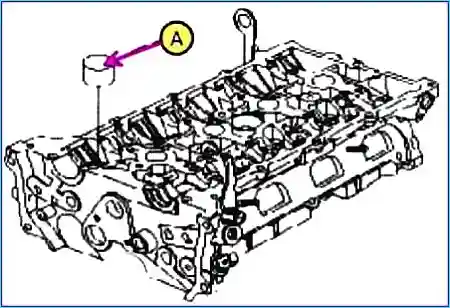
Remove from the cylinder head tappets (A)
Remove the valves. To do this:
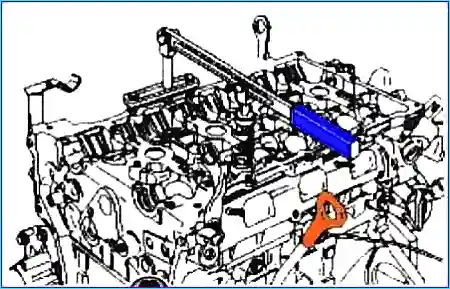
Using special tools (09222-3K000, 09222-ZK10), compress the spring and remove the valve crackers, as shown in the figure
Checking the technical condition of the cylinder head parts
Cylinder head
Check the non-flatness of the surface of the cylinder head joint with the block.
To do this, you need to use a special ruler and a set of feeler gauges.
Placing the ruler in the planes indicated in the figure, measure the non-flatness of the connector surface with feeler gauges.
Standard value of surface non-flatness; less than 0.05 mm.
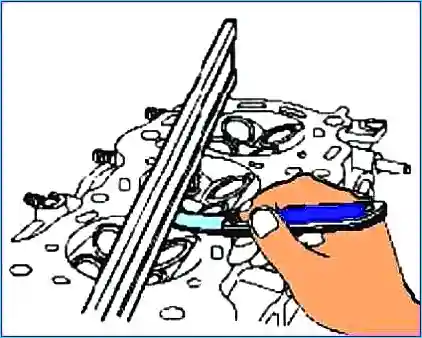
Check the combustion chambers, intake and exhaust ports and the joint surface with the cylinder block for damage.
If any defects are found, replace the cylinder head assembly.
Valves, tappets, guide bushings and valve springs
Check the technical condition of the guide bushings and valves.
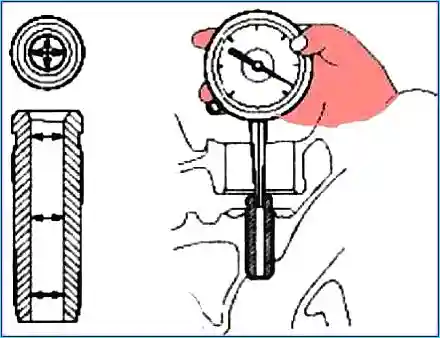
Using a bore gauge, measure the inside diameter of the valve guide as shown in the figure.
Standard inside diameter; 5.500 – 5.512 mm.
Using a micrometer, measure the outside diameter of the valve stem as shown in the figure.
Standard valve outside diameter: 5.465 - 5.480 mm (intake), 5.458 - 5.470 mm (exhaust).

The difference between the inside diameter of the guide bushing and the outside diameter valve stem is the gap between the valve and the bushing.
If the gap is greater than the maximum permissible value, the valve must be replaced together with the bushing.
Check the technical condition of the valves.
Check the sharpening angle of the working chamfer of the valve head.
Check the valve surface for increased wear. If any defects are found, replace the valve with a new one.
Check the thickness of the valve head belt.
If the thickness of the valve head belt is less than the permissible value, it is necessary to replace the valve with a new one.
Standard value of belt thickness: 1.02 mm (inlet), 1.09 mm (outlet).
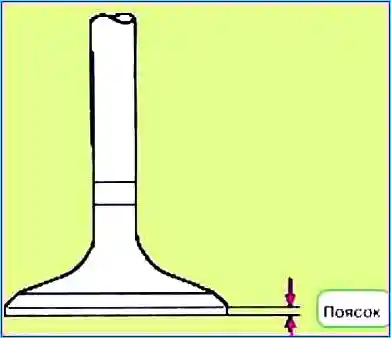
Measure the overall length of the valve. Standard valve length: 113.18 mm (inlet), 105.84 mm (outlet).
Check the technical condition of the valve seats.
Check that the valve fits tightly to the seat, along its entire circumference. Replace the valve seats if necessary.
Before restoring the valve seats, it is necessary to check the technical condition of the valve guide bushings.
If any defects are detected, it is necessary to replace the bushing, and then restore the seat.
The thickness of the working surface of contact of the seat with the valve must correspond to the standard value.
Check the technical condition of the valve springs.
Using a steel square, measure the deviation from the vertical axis of the spring.
Permissible deviation from the vertical axis: 1.5˚. maximum permissible deviation: 3˚.
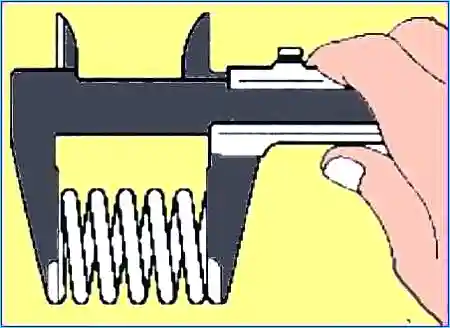
Using a caliper, measure the free length of the spring. The standard value for the spring length is 47.44 mm.
If the free length of the spring does not correspond to the standard value, it is necessary to replace the spring.
Using a micrometer, measure the outside diameter of the tappet. The standard value is 31.964 - 31.980 mm.
Using a caliper, measure the inside diameter of the tappet hole in the cylinder head, the value is: 32.000 - 32.025 mm.
Subtract the outside diameter measurement from the inside diameter of the tappet to determine the clearance, the value is: 0.020 - 0.061 mm. The limit value is 0.07 mm.
Distribution shaft
Using a micrometer, measure the height of the camshaft lobes.
Standard cam height values: 44.10 - 44.30 mm (intake), 44.90 - 45.10 mm (exhaust).
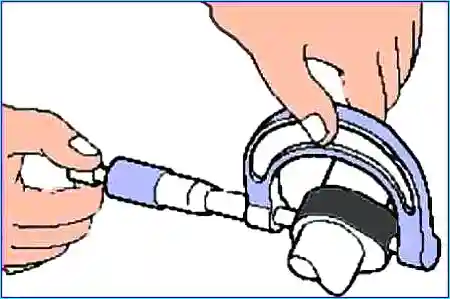
NOTE:
If the camshaft lobes are less than the minimum, the camshaft must be replaced assembly.
Check the clearance in the camshaft bearings.
Clean and wash the bearing caps and camshaft journals.
Install the camshafts in the cylinder head.
Place special plastic gauges on the camshaft journals, as shown in the figure.
Install the camshaft bearing caps.
Do not turn the camshaft.
Remove the camshaft bearing caps.
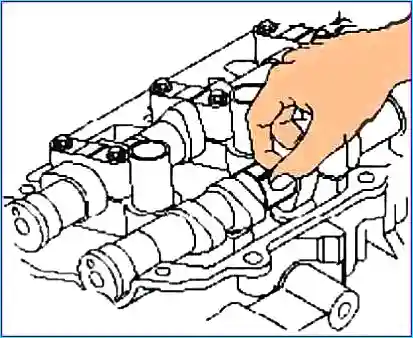
Measure the thickness of the plastic gauge (a scale is included with the plastic gauge kit). From this, determine the clearance in the bearings.
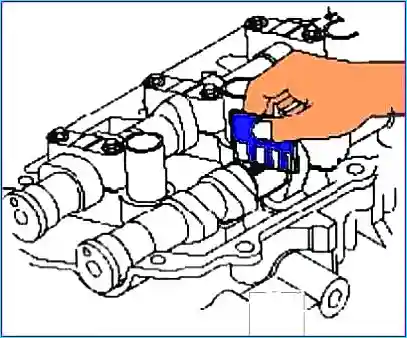
Standard value of the bearing clearance:
- No. 1: 0.022 – 0.057 mm, No. 2, 3, 4, 5: 0.045 – 0.082 (inlet),
- No. 1: 0 – 0.032 mm, No. 2, 3, 4, 5: 0.045 – 0.082.
Maximum permissible:
No. 1: 0.09 mm, No. 2, 3, 4, 5: 0.12 mm (inlet); 0.12 (outlet).
If the bearing clearance exceeds the permissible limit, it is necessary to replace the camshaft.
If necessary, replace the bearing caps or the cylinder head assembly.
Remove the plastic gauges.
Remove the camshafts.
Measure the axial clearance of the camshaft.
Install the camshafts.
Using a dial indicator, measure the axial clearance by moving the camshaft forward / backward.
Standard axial clearance of the camshaft: 0.04 - 0.16 mm. Maximum permissible: 0.24 mm.
If the axial clearance exceeds the maximum permissible value, it is necessary to replace the camshaft.
If necessary, replace the camshaft bearing caps and the cylinder head assembly.
Remove the camshafts.
Exhaust camshaft bearing
Check the cylinder head bore mark.
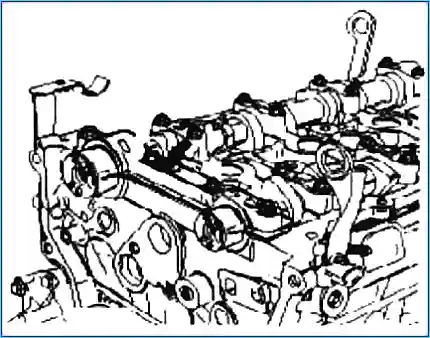
Label location:
Class - mark - inner diameter of the exhaust camshaft hole, mm:
- a - A - 40.000 – 40.008;
- b - B - 40.008 – 4.016;
- c - C - 40.016 – 40.024
Select the bearing class the same as cylinder heads as shown in the table.
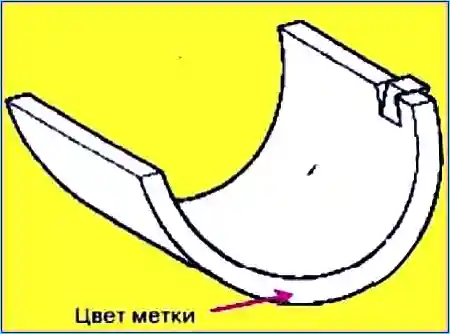
Label location:
Class - label - liner thickness, mm:
- a (A) - C (green) - 1.996 – 2.000;
- b (B) - B (no color) - 2.000 – 2.004;
- c (C) - A (black) - 2.004 – 2.008
Oil clearance: 0 - 0.0З2mm.
Variable valve timing mechanism assembly (phase shifter)
Check the technical condition of the variable valve timing mechanism assembly.
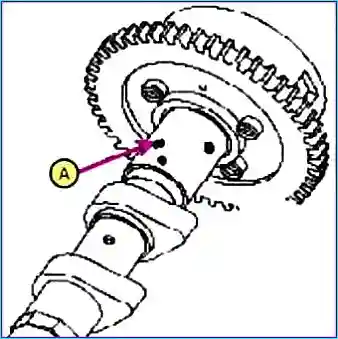
Check and make sure that the mechanism does not rotate.
Wrap all parts of the mechanism with vinyl tape, except for one, indicated in the figure below
Wrap a special air gun, then apply 150 kPa pressure to the hole on the camshaft (when performing this operation, remove the locking pin).
Assembly
After spraying engine oil, wipe the surfaces with a rag.
During the above operation, manually turn the phase shifter assembly in the advance direction (the direction is indicated in the figure above by an arrow).
When compressed air is supplied, the phase shifter should be moved in the advance direction without effort, by hand.
Except for the position when the locking pin reaches the maximum deviation in the direction of delay.
After this, turn the phase shifter back.
Check the smoothness of its movement, excluding jamming, the range of movement of the phase shifter is 22.5˚ (inlet), 20˚ (exhaust).
Turn the phase shifter assembly by hand and fix it in the maximum position of delay.
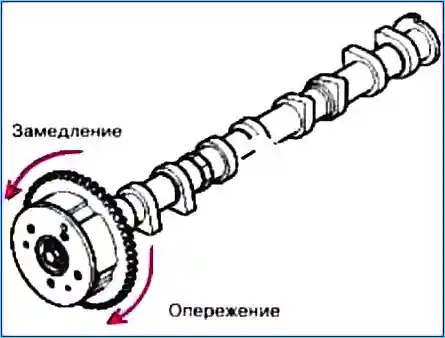
Install the valves.
Install the lower valve spring supports.
Using a special device (09222-4A000), install the valve stem seal.
Do not reuse the valve stem seal.
Incorrect installation of the valve stem seal can lead to engine oil leaks through the valve guide.
Install the valve, valve spring and upper spring support.
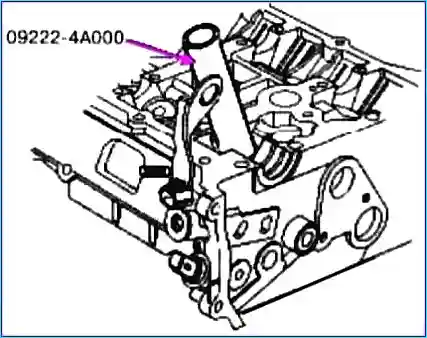
Using a special device (09222-ЗК000, 09222-3К100), compress the valve spring and install the valve crackers.
After installation, make sure that the crackers are installed properly.
The valve spring must be installed so that the polished part of the coils is directed upwards (towards the upper support).
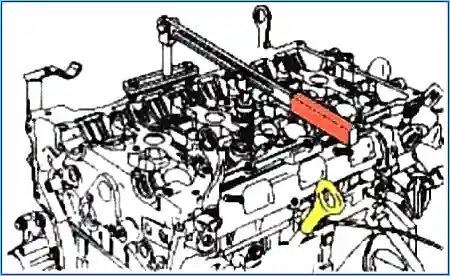
Apply several light blows with a wooden hammer handle to the valve stems to ensure that the crackers have properly secured the valves.
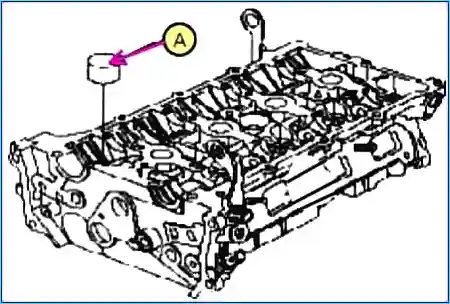
Install the valve tappets "A".
Check and ensure smooth movement pusher





